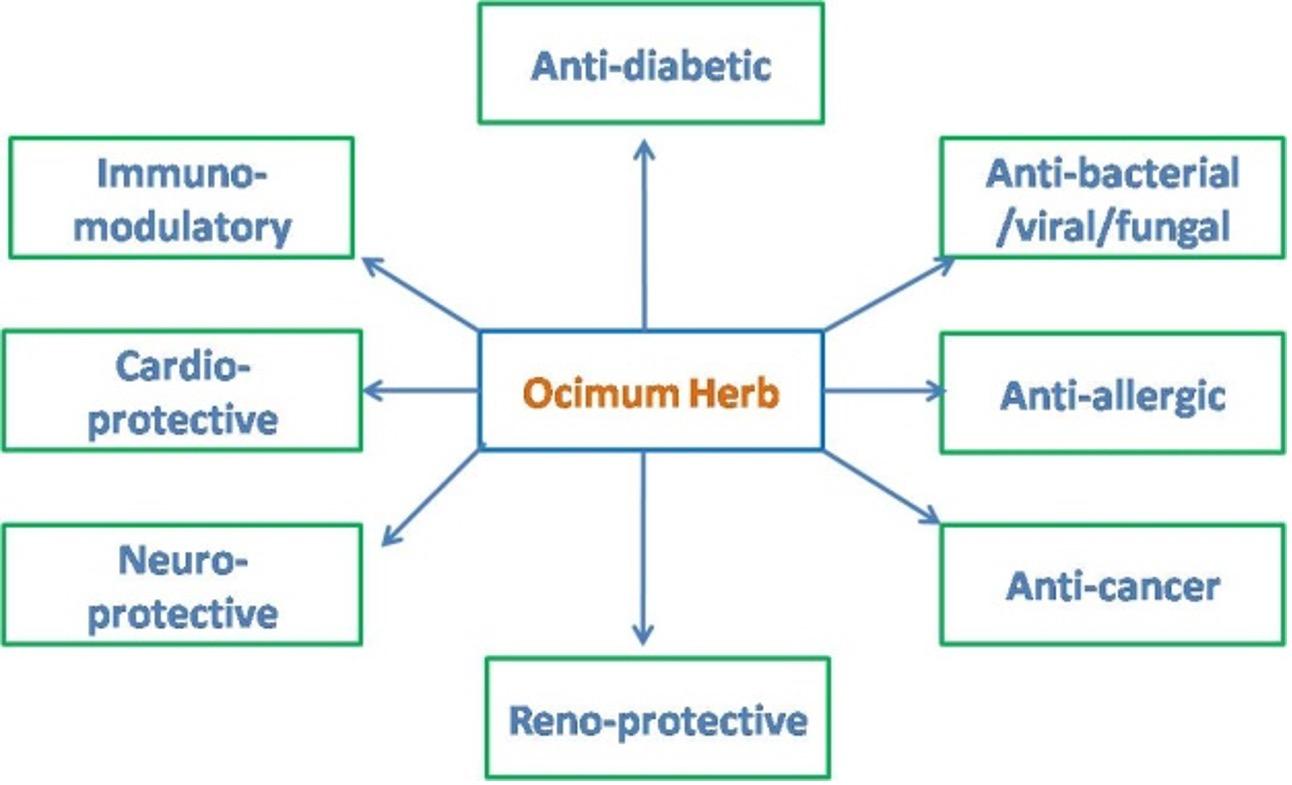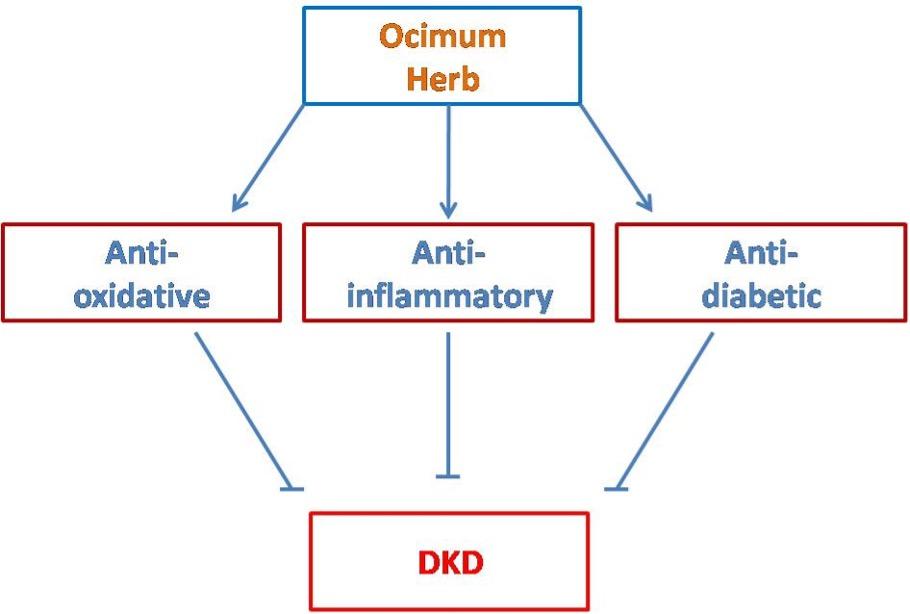Ocimum herb species: a potential treatment strategy for diabetic kidney disease.
Abstract
Ocimum genus most commonly termed as Tulsi, an aromatic plants belongs to family Lamiaceae. In addition to anti bacterial activity, anti-oxidant, anti diabetic, cardio protective, neuroprotective, radio-protective, anti-cancer, and free radical scavenging properties, quite a few studies have reported that this traditionally grown medicinal herb may become a potential therapy for diabetic kidney disease (DKD). This paper will significantly review Tulsi plants role in treatment of DKD to provide reference for future research.
INTRODUCTION
Ocimum sp or Tulsi is one of the precious medicinal plants in India which is considered as a queen of herbs. The genus Ocimum includes at least 30 species which have established in tropics and sub-tropical regions. Leaves and flowering tops are vital in extracting the essential oil. Oil of O. sanctum is discovered to have five fatty acids (stearic, palmitic,oleic and linoleic and linolenic acids). It is said to be resource of beta carotene, calcium,vitamin C. Eugenol, beta-cymne, Carvacol are naturally occurring chemicals in tulsi leaves which have tremendous use as anti bacterial activity. Linalool and Rosamarinic acid have anti oxidant and mosquito repellents. It can assist in normalizing blood glucose, blood pressure and lipid profiles and also dealing with psychological and immunological stress [1,2]. Different species of this medicinal plant incorporated with herbal medicine.
Since, plants are considered to be source of medicines and of those medicinal plants measured as loaded with secondary metabolites and oils which are of healing significance. In this review, we summarized the currently potential and possible mechanisms underlying the action of tulsi oils and metabolites for therapy of diabetic kidney disease and expect many more studies for further verification.
THERAPEUTIC USES OF OCIMUM SPECIES
A variety of medicinal properties have been credited to O. sanctum. Whole tulsi plant has been found to possess several healing properties. Flower, Leaf, Stem, Root, every part of the plant is used as an expectorant, analgesic, anticancer, anti asthmatic, anti-emetic, diaphroretic, anti-diabetic, anti-fertility, hepato protective, hypotensive, hypolipidemic etc [1].
Ocimum gratissimum could significantly reduce cell viability of lung adeno carcinoma even at the lower concentrations of 500-800 micrograms per ml. Ocimum gratissimum inhibits the activation of ERK but can enhances activation of JNK, P38 to trigger apoptotic cascade in lung adenocarcinoma [3]. Few other studies related with epoxide forms of lutein, eugenol and lupeol induce p53 thereby decreasing expression of bcl-2 and increasing expression of BAX proteins to trigger apoptosis in MCF-7 and MDA-MB-231 cells [4]. Tulsi essential oils largely composed of monoterpenes which have been proved as cytotoxic in various cell lines HePG2, HU60, MCF7, Hela, U 251 as well as VERO cell [5]. When LNCaP cells were treated with ethanolic extracts of tulsi, 24 h and 48 h of treatment significantly resulted in apoptosis via activation of caspase3 and caspase9, thereby resulted in DNA fragmentation and cell death [6]. Oflate, researchers are drawing importance of tulsi in eradication of various kinds of cancer in possible ways.
Leaf extract of Ocimum sanctum significantly decreases blood glucose in glucose induced hyperglycemic and STZ-induced diabetic rats. The result was more effective with the normal and hyperglycemic conditions of in-vivo studies. Dropping down blood glucose and uronic acid and increasing the lipid profile is the consequence feature. Overall tulsi plants have anti-diabetic potentials in many ways [7–9].
The administration of extract of Ocimum sanctum in combination with Ginkgo biloba showed cardioprotective effect by protecting ventricular dysfunction via increasing level of antioxidant enzyme and decreasing the production of free radicals [10]. Another study revealed that the administration of homogenate of leaves of Ocimum sanctum for 30 days showed preventive action in isoproterenol-induced myocardial necrosis in wistar rats through increasing the level of endogenous antioxidants [11].
Few studies also confirmed that supplement of Ocimum products could successively lower the fasting blood glucose and postprandial glucose and HbA1c thereby resulting the hypoglycemic effect [12,13]. Striking feature is that the increasing diabetes is prone to cancer commencement. Further, fresh leaf and stem extracts of Ocimum own very good antioxidant properties so they have involved in prevention of excess oxidation, increasing SOD, CAT, GSH, GPx anti oxidant enzymes thus protecting cells from damage by scavenging highly free radicals [14]. Besides, anti-inflammatory potential of ocimum has been found [15–17].
Antihypertensive effects of Ocimum basilicum L. on blood pressure in renovascular hypertensive rats have been reported [18]. Ocimum gratissimum (L.) (Lamiaceae) and its ursolic acid and ellagic acid, were studied for their inhibitory activity against rat lens and kidney. In addition, in vivo inhibition of lens galactitol accumulation by the major constituents of the plants in galactose-fed rat has been studied. The plants and their major constituents as possible protective agents against long-term diabetic complications [19]. In vitro anti-inflammatory, antioxidant and nephroprotective studies on leaves of Ocimum sanctum [20]. In addition, protection against mercury-induced renal damage in Swiss albino mice by Ocimum sanctum [21].
Diabetic kidney disease (DKD) is the most common cause of end-stage kidney disease [22]. Oxidative stress is a key factor responsible for progression of DKD [23]. As clinical trials of several antioxidants against oxidative stress-associated tissue injury have failed [24], inhibiting reactive oxygen species (ROS) generation might become a promising strategy to treat DKD. Current therapy including tight control of blood glucose and blood pressure and inhibition of angiotensin might delay but does not stop the development and progression of kidney injury in diabetes [25]. Therefore, new and comparatively more effective therapeutic measures for diabetic nephropathy are essential. Considering all, ocimum herbs may become a potential therapeutic strategy for treatment of DKD.
FUTURE PROPECTS AND CONCLUSIONS
Diabetes and kidney diseases are the diseases of multi factor type so we should always rely on view of multi dimensional treatment. In Asian countries medicinal herbs are of great importance. They are easily available and cost effective. Although there is no long term practice or large scale clinical trials, till date data suggested that Genus Ocimum is safe, effective herb towards normalizing glucose, blood pressure and lipid profiles and dealing with psychological and immunological stress. Also revealed that tulsi has a unique combination of actions that include: Antimicrobial (including antibacterial, antiviral, antifungal, antiprotozoal, antimalarial, anthelmintic), mosquito repellent, anti-diarrheal, anti-oxidant, anti-cataract, anti-inflammatory, chemopreventive, radioprotective, hepato-protective, neuro-protective, cardio-protective, anti-diabetic, anti-hypercholesterolemia, anti-hypertensive, anti-carcinogenic, analgesic, anti-pyretic, anti-allergic, immunomodulatory, central nervous system depressant, memory enhancement, anti-asthmatic, anti-tussive, diaphoretic, anti-thyroid, anti-fertility, anti-ulcer, anti-emetic, anti-spasmodic, anti-arthritic, adaptogenic, anti-stress, anti-cataract, anti-leukodermal and anti-coagulant activities [26]. These are now summarized in Figure 1.

Furthermore, these studies indicate the daily addition of tulsi to the diet and/or as adjunct to drug therapy can potentially assist in prevention or reduction of various kidney diseases including DKD. Our suggested scheme for Ocimum herb induced anti-DKD effects have been shown in Figure 2.

AUTHOR CONTRIBUTIONS
IP conceived the study; IP and AM collected the data; IP and AM wrote the paper.
CONFLICT OF INTEREST
The authors declare that no conflicts of interest exist.
References
- [1]Ch M, Naz S, Sharif A, Akram M, Saeed M. Biological and Pharmacological Properties of the Sweet Basil (Ocimum basilicum). Br J Pharm Res 2015. doi:10.9734/BJPR/2015/16505.
- [2]Bucktowar K, Bucktowar M, Devi Bholoa L. A review on sweet basil seeds: Ocimum basilicum. 554 Bucktowar Al World J Pharm Pharm Sci 2016. doi:10.20959/wjpps201612-8205.
- [3]Chen H-M, Lee M-J, Kuo C-Y, Tsai P-L, Liu J-Y, Kao S-H. Ocimum gratissimum Aqueous Extract Induces Apoptotic Signalling in Lung Adenocarcinoma Cell A549. Evid Based Complement Alternat Med 2011. doi:10.1155/2011/739093.
- [4]Behbahani M. Evaluation of in vitro anticancer activity of Ocimum basilicum, Alhagi maurorum, Calendula officinalis and their parasite Cuscuta campestris. PLoS One 2014. doi:10.1371/journal.pone.0116049.
- [5]Ibrahim AY, Ibrahim FM, Mohamed EI. Evaluation of Antiproliferative and cytotoxic activities of Tulsi essential oils. Int J ChemTech Res 2015.
- [6]Upadhyay RK. Tulsi: A holy plant with high medicinal and therapeutic value. Int J Green Pharm 2017
- [7]Modak M, Dixit P, Londhe J, Ghaskadbi S, Paul a DT. Indian herbs and herbal drugs used for the treatment of diabetes. J Clin Biochem Nutr 2007. doi:10.3164/jcbn.40.163.
- [8]Grover JK, Yadav S, Vats V. Medicinal plants of India with anti-diabetic potential. J Ethnopharmacol 2002. doi:10.1016/S0378-8741(02)00059-4.
- [9]Malapermal V, Botha I, Krishna SBN, Mbatha JN. Enhancing antidiabetic and antimicrobial performance of Ocimum basilicum, and Ocimum sanctum (L.) using silver nanoparticles. Saudi J Biol Sci 2017. doi:10.1016/j.sjbs.2015.06.026.
- [10]Sood S, Narang D, Dinda AK, Maulik SK. Chronic oral administration of Ocimum sanctum Linn. augments cardiac endogenous antioxidants and prevents isoproterenol-induced myocardial necrosis in rats. J Pharm Pharmacol 2005. doi:Doi 10.1211/0022357055146.
- [11]Pattanayak P, Behera P, Das D, Panda S. Ocimum sanctum Linn. A reservoir plant for therapeutic applications: An overview. Pharmacogn Rev 2010. doi:10.4103/0973-7847.65323.
- [12]Jamshidi N, Cohen MM. The Clinical Efficacy and Safety of Tulsi in Humans: A Systematic Review of the Literature. Evidence-Based Complement Altern Med 2017. doi:10.1155/2017/9217567.
- [13]Somasundaram G, Manimekalai K. Evaluation of the antidiabetic effect of Ocimum sanctum in type 2 diabetic patients. Int J Life Sci Pharma Res 2012.
- [14]Panda VS, Naik SR. Evaluation of cardioprotective activity of Ginkgo biloba and Ocimum sanctum in rodents. Altern Med Rev 2009.
- [15]Rodrigues LB, Oliveira Brito Pereira Bezerra Martins A, Cesário FRAS, Ferreira e Castro F, de Albuquerque TR, et al. Anti-inflammatory and antiedematogenic activity of the Ocimum basilicum essential oil and its main compound estragole: In vivo mouse models. Chem Biol Interact 2016. doi:10.1016/j.cbi.2016.07.026.
- [16]Kapewangolo P, Omolo JJ, Bruwer R, Fonteh P, Meyer D. Antioxidant and anti-inflammatory activity of Ocimum labiatum extract and isolated labdane diterpenoid. J Inflamm (United Kingdom) 2015. doi:10.1186/s12950-015-0049-4.
- [17]Singh S, Majumdar DK, Rehan HMS. Evaluation of anti-inflammatory potential of fixed oil of Ocimum sanctum (Holybasil) and its possible mechanism of action. J Ethnopharmacol 1996. doi:10.1016/0378-8741(96)83992-4.
- [18]Umar A, Imam G, Yimin W, Kerim P, Tohti I, Berké B, et al. Antihypertensive effects of Ocimum basilicum L. (OBL) on blood pressure in renovascular hypertensive rats. Hypertens Res 2010. doi:10.1038/hr.2010.64.
- [19]Rao AR, Veeresham C, Asres K. In vitro and in vivo inhibitory activities of four Indian medicinal plant extracts and their major components on rat aldose reductase and generation of advanced glycation endproducts. Phytother Res 2013. doi:10.1002/ptr.4786.
- [20]Reshma, Arun KP, Brindha P. In vitro anti-inflammatory, Antioxidant and nephroprotective studies on leaves of Aegle marmelos and Ocimum sanctum. Asian J Pharm Clin Res 2014.
- [21]Sharma MK, Kumar M, Kumar A. Protection against mercury-induced renal damage in Swiss albino mice by Ocimum sanctum. Environ Toxicol Pharmacol 2005. doi:10.1016/j.etap.2004.06.002.
- [22]Baynes JW, Thorpe SR. Role of Oxidative Stress in Diabetic Complications. Diabetes 1999. doi:10.2337/diabetes.48.1.1.
- [23]Forbes JM, Coughlan MT, Cooper ME. Oxidative stress as a major culprit in kidney disease in diabetes. Diabetes 2008. doi:10.2337/db08-0057.
- [24]Bjelakovic G, Nikolova D, Gluud LL, Simonetti RG, Gluud C. Mortality in randomized trials of antioxidant supplements for primary and secondary prevention: systematic review and meta-analysis. JAMA 2007. doi:10.1016/S0093-3619(08)70874-8.
- [25]Brenner BM, Cooper ME, de Zeeuw D, Keane WF, Mitch WE, Parving HH, et al. Effects of losartan on renal and cardiovascular outcomes in patients with type 2 diabetes and nephropathy. N Engl J Med 2001. doi:10.1056/NEJMoa011161.
- [26]Cohen M. Tulsi – Ocimum sanctum: A herb for all reasons. J Ayurveda Integr Med 2014. doi:10.4103/0975-9476.146554.